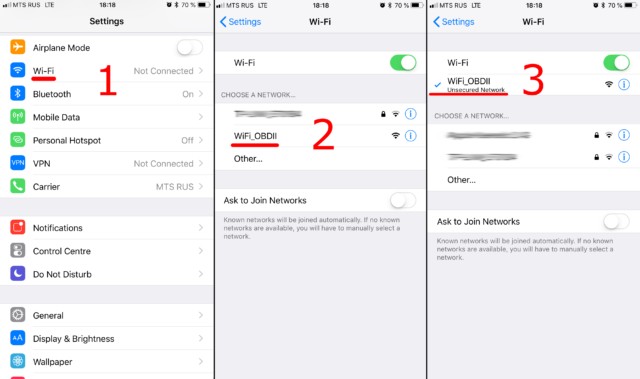First things first, ensure you have an OBDII ELM327 adapter that supports a Wi-Fi connection. This type of adapter allows your car’s diagnostic system to communicate wirelessly with your smartphone or tablet, opening up a world of vehicle data and diagnostics. Let’s walk through the steps to get connected.
Step 1: Plug in and Power On Your OBD2 WiFi Adapter
Locate the OBDII socket in your vehicle, typically found under the dashboard on the driver’s side. Plug your OBD2 WiFi adapter securely into this socket.
Once plugged in, you’ll need to power on the adapter. For most OBD2 WiFi adapters, simply turning on your car’s ignition or starting the engine will provide power to the adapter. Some adapters might have a power button directly on the device; if yours does, make sure to press it to activate the adapter.
Step 2: Connect to the OBD2 WiFi Network on Your Phone or Tablet
Now, grab your smartphone or tablet and navigate to the Wi-Fi settings. It’s crucial to open your device’s Wi-Fi settings, not the settings within your car scanner app at this stage. Turn on Wi-Fi if it’s not already enabled.
Your OBD2 WiFi adapter will broadcast a Wi-Fi network. Search for this network in your device’s list of available Wi-Fi connections. Common network names you might see include “OBDII,” “OBD2,” or “WIFI_OBDII.” Sometimes, the network name will reflect the adapter’s brand, such as “VLINK” for VGate adapters.
Select the OBD2 WiFi network and connect to it. In most cases, these adapters do not require a password. However, if your adapter prompts for a password, consult the documentation that came with your OBD2 adapter. Importantly, the network name will never be your car’s brand name.
Step 3: Configure Your Car Scanner App for WiFi Connection
With your device connected to the OBD2 WiFi network, open your car scanner application. The next step is to configure the app to communicate with your OBD2 adapter via WiFi.
Access the app’s settings menu. This is usually represented by a gear icon, often located in the top-right corner of the app’s main screen.
Within the settings menu, look for an option labeled “Adapter” or, in older versions of some apps, “Connection.” Tap on this option to access the adapter connection settings.
Here, you will need to select the “Wi-Fi” connection type. This tells the car scanner app to look for and communicate with your OBD2 adapter over the WiFi network you’ve just connected to.
Finally, verify the adapter’s IP address and port settings within the app. For the majority of OBD2 WiFi adapters, the default IP address is 192.168.0.10 and the port is 35000. However, some adapters may use different settings. It’s always best to refer to the documentation provided with your specific OBD2 WiFi adapter to confirm these details. Correct IP address and port settings are essential for establishing a successful connection.
Step 4: Connect and Start Diagnosing
With all the configurations in place, you’re now ready to connect your car scanner app to your vehicle’s OBD2 system. Look for a large, prominent “Connect” button within the car scanner app, usually green in color and located on the main screen or dashboard area. Tap this button to initiate the connection.
The app will now attempt to establish a connection with your OBD2 WiFi adapter and retrieve data from your car’s computer. Once connected, you can start using the car scanner app to perform diagnostics, read fault codes, monitor live data, and much more, all wirelessly via your Obd2 To Wifi setup.
For subsequent connections, ensure your device is connected to the OBD2 WiFi network again and simply tap the “Connect” button in your car scanner app. Enjoy the convenience of wireless car diagnostics!
Troubleshooting iOS Wi-Fi Connection
If you encounter issues connecting on an iOS device, double-check that you have correctly selected the WiFi connection type in your car scanner app and verified the IP address and port settings. Sometimes, restarting your device or the car’s ignition can also resolve connection problems. Consulting your OBD2 adapter’s documentation or the car scanner app’s help resources can provide further troubleshooting guidance.

